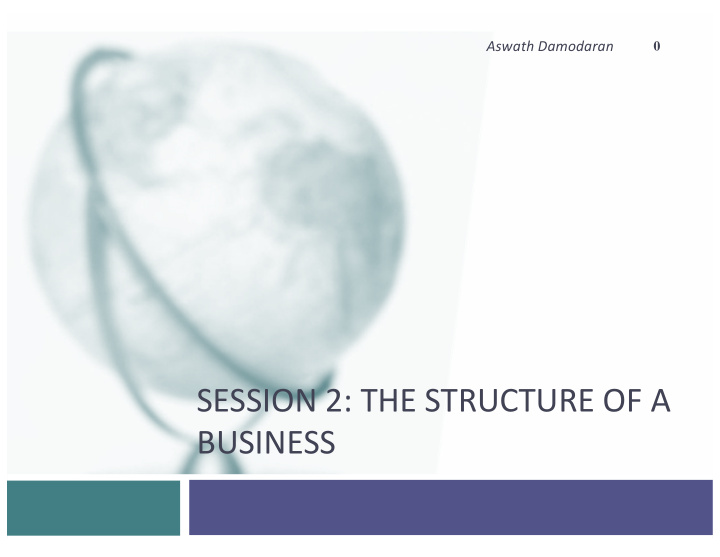



Aswath Damodaran 0 SESSION 2: THE STRUCTURE OF A BUSINESS
A Financial Balance Sheet 1
Assets in Place • The assets in place reflect investments that a business has already made. The investments were made in the past, but the value that is attached to them is your estimate of what they will generate for you in the future. • With this definition, you can see that the value of assets in place can be • Significantly lower than what you originally invested, if their earnings power has deteriorated. • Significantly higher than what you originally invested, if their earnings power has improved. • About what you invested, if the earnings power has stagnated. 2
Growth Assets ¨ Growth assets reflect the value of investments that you expect a business to make in the future. ¨ That value is measured by the “excess returns” you expect to generate on future investments. ¨ The value of growth assets will be ¤ Higher, if you are in a business where you access to lots of investments that generate excess returns ¤ Lower, if you are in a business that either has very few investments or low or zero excess returns ¤ Negative, if you are in a business with bad investments and you make them anyway. 3
Debt 4 ¨ You have the choice of borrowing money to fund some or a big part of your value. ¨ There are three characteristics that set debt apart from equity: ¤ Contractual commitments to make payments to the lenders (interest & principal) ¤ Failure to meet these commitments can result in you going out of business or losing your equity stake ¤ In much of the world, the tax law is tilted to give you a benefit when you borrow Aswath Damodaran 4
Equity 5 ¨ Equity is a residual claim. If you are the sole owner of a business, you are entitled to lay claim on whatever cash flows are left over after every one else has been paid their contractual dues. ¨ The Dividend Claim: If you are the stockholder in a public company, the managers have the discretion to decide how much of the cash flows are paid out to you as dividends. Aswath Damodaran 5
The Corporate Life Cycle The Lightbulb (Idea) Moment The Bar Mitzvah The End Game The Midlife Crisis From idea to business The Scaling up Test Revenues $ Revenues/ Earnings Earnings Time Stage 1 Stage 2 Stage 3: Stage 4 Stage 5 Stage 6 Growth stage Start-up Young Growth High Growth Mature Growth Mature Stable Decline Have an idea for Create a business Build the Grow your Defend your Scale down a business that model that business, business, business from your business Description meets an unmet converts ideas converting shifting from new as market need in the into potential potential into losses to competitors & shrinks. market. revenues & revenues. profits find new earnings markets 6
The Asset Side across the Life cycle 7
The Financing Side 8 Financing Choices across the life cycle Revenues $ Revenues/ Earnings Earnings Time External funding High, but High, relative Moderate, relative Declining, as a Low, as projects dry needs constrained by to firm value. to firm value. percent of firm up. infrastructure value Negative or Negative or Internal financing Low, relative to High, relative to More than funding needs low low funding needs funding needs External Owner’s Equity Venture Capital Common stock Debt Retire debt Financing Bank Debt Common Stock Warrants Repurchase stock Convertibles Stage 1 Stage 2 Stage 4 Stage 5 Growth stage Stage 3 Start-up Rapid Expansion Mature Growth Decline High Growth Financing Accessing private equity Inital Public offering Seasoned equity issue Bond issues Transitions Aswath Damodaran 8
The Harvesting Side 9 Aswath Damodaran 9
Recommend
More recommend